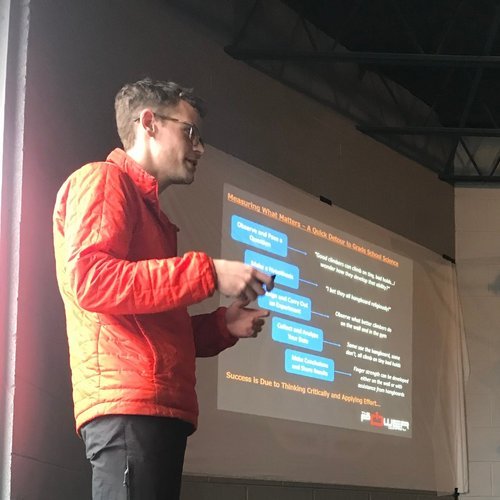Too Easy to Fail
I’ve tried, and failed, to complete more hangboard programs than most people have heard of. I’m not a training machine. I can’t just shut my brain off, sacrifice the enjoyment I get from climbing, and put in the work. I wish I could, but I can’t.
To me, hangboarding was always one of those things that looked better on paper. I hang from some small edges, my fingers get stronger, and then I crush all the boulders? Sign me up. However, in practice, I could never make it happen. I just really enjoy climbing, and I was still getting better without hangboarding, so it never seemed that urgent.
The Problem
It finally hit me when I realized I couldn’t move on with any of my projects because I wasn’t able to hang on to small enough holds. I felt stuck. In order for me to continue doing new boulders, I had to keep searching out a more and more narrow selection of climbs. If there was so much as one small crimp on a boulder, I would get shut down, even if it wasn’t one of the "hard moves."
I had tried hangboarding in the past. In fact, through trial and error, I managed to develop a fairly consistent system for it. I would read about a new training method, think to myself, “This time, I’ll stick with it," and then immediately start dreaming of all the boulders and routes I would dismantle with my new-found finger strength. I’d draw up a grid in the back of a notebook for recording the program. Six weeks later... I would take that journal out of my gym bag because I hadn’t actually used it for four weeks.
I needed stronger fingers and I knew that if I could stick with it, hangboarding would get me where I wanted to be. This time though, I would make it impossible to fail.
On the topic of goal setting, author Tim Ferriss uses the approach of “rigging the game so that you can’t lose.” As an example, instead of saying that you will do core workouts five times a week, pick a much smaller goal, like twice a week. That way, if you only hit four days one week, instead of being a failure and potentially quitting, you just doubled your goal. Celebration pizza. Eventually, as you create a habit out of the initial goal, you can slowly increase the measurement. I decided to take this approach with hangboarding.
The Plan
It didn’t take long for me to think up the lowest commitment hangboard routine possible. Two hangs, no added weight, just the smallest edge that I could comfortably hang for 10 seconds. It came out to be 20 seconds of work, no real set-up time necessary since I wasn’t adding weight, and it was brief enough that it didn’t detract from the rest of my climbing session.
I did this every day that I was in the gym and having a hard session, typically this was three to four days a week. I would warm up for around 30-45 minutes, getting to the point where I felt like I could try at a project level. Then I would do my 10-second hang, rest 4 minutes, hang again, and then carry on with the rest of my session. It was too easy not to do.
Application
I followed this plan for three months. On my first day, I couldn’t hang on the smallest edge on the MoonClimbing Moon Training Fingerboard (#4) so I did my hangs on the next smallest (#3). After a few weeks, that edge felt too easy so I made the move to the smaller hold. The first attempt at the small hold was fairly hard, and I didn’t successfully make it to the full 10 seconds until my fourth or fifth day of trying. I would still step off just before failure, though. After two months, I was having to grab the smallest edge with less and less skin to make the hang difficult enough.
Results
After three months, I was on the verge of leaving for a climbing trip out west. I decided to test my strength by seeing how long I could hang on the smallest edge. I hung for 30 seconds before deciding to step off. That was all I needed to see. Celebration doughnuts.
On that trip, I went out and tried to climb as many crimp boulders as possible. It was amazing. For the first time in years, I felt like I wasn’t limited to what I could try. This included boulders in Hueco Tanks that I couldn’t even pull off the ground on in the past, and I even nabbed my first V10 flash on the crimpy "Finger Hut" in Joe’s Valley. Another very pleasant result from hangboarding was that my fingers no longer felt tweaky on small holds. I was able to climb on a much broader variety of styles, and my fingers were the healthiest they had been in years.
"Finger Hut" in Joe's Valley.
My purpose here is not to promote my method for hangboarding. There are plenty of reasons why that method isn’t the best practice. If I had been more willing to stick with a well-established and structured plan, I’m sure I would have had even better results. However, I wasn’t, so for me this was the best plan. Since then, I have followed more structured plans and have had great results from them. I just had to take a small step in the right direction first.
If you’re consistent with your training, and are looking for a good, well-proven method for hangboarding check out some of these options:
Eva Lopez - And if you haven't already, check out Kris's review of the Transgression Board here.
Beastmaker - They also have an app with workouts designed specifically for their hangboards.
The Anderson's training method is another fairly popular method, and can be found in the Rock Climber's Training Manual.
These can all work, and work well. My recommendation is to read through them, find the one that you believe that you can stick with consistently, and go for it. Then finish the program.
What I am really saying is that consistency is king. Even the best program is worthless if you don’t stick with it. Don’t let yourself get overwhelmed by the idea that you need to be on some massive life-changing training plan if you want to see any progress. Start with something small and do it frequently. I didn’t do anything special; I just made it so easy that I couldn’t fail. This can be applied to anything. Whatever you want to improve, just take the smallest step in the right direction. And then when that step no longer feels like a great effort, take another step.
When I first started climbing, I hated the idea of long-term thinking. I wanted to be as strong as possible as quickly as possible. Now that I’ve been climbing eleven years, I’m able to see the big picture a bit better. It’s no surprise that my greatest improvements have never come from some shiny new exercise or program, but instead, from simplifying things and working towards getting a little bit better at the basics.
It’s easy to romanticize the idea of building a training wall in your mom’s basement and locking yourself in there for several months, only to emerge as an 8B crushing choss beast. It’s way less fun to think about the little habits you could be implementing routinely to see improvement several months from now.















Being able to quickly recognize familiar sequences is a crucial ingredient to harder climbing.